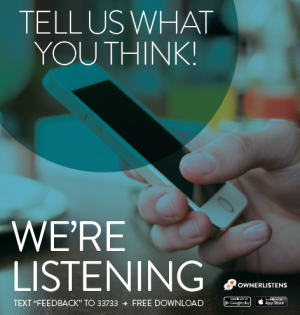At OwnerListens we always say that “feedback is a gift” and we mean it. What could be better than someone telling you the truth about your business? Mistakes happen and if you don’t know about them, you’re missing out on important information. Compliments and suggestions can be just as valuable as complaints, so treat them as a learning opportunity as well.
Here’s what you can do to make the most out of your reviews:
A. Really read each review thoroughly. Put yourself in the shoes of the customer and imagine the situation from her point of view as someone who knows nothing about you or your business. Then ask yourself, would you want to go back to this place given this feeling? What would you change to make you, as a customer, want to go back.
B. Track review trends over time. While any one review could be subjective, biased or even fake, trends based on many reviews are much more credible. You should track the reviews breakdown for each location on a weekly basis. Count how many reviews the place received that week, multiply that number by five (the total number of available stars), then count how many stars total it received out of the total available number. The number of stars received divided by the number of stars available will give you a score. By tracking this score every week you can detect a downward trend and meet it head on.
It’s hard to assign value to this without a high volume of reviews. This is yet another reason to encourage customers to provide reviews.
Don’t be confused about what the score is telling you. If your score is declining there could be several things at play:
1. The business’ service or product quality really has declined.
2. The business is not doing a good job explaining to customers how to privately complain.
3. Someone is trying to ruin the business’ reputation by posting fake negative scores.
It’s hard to discern from the data available to the business owner, what exactly is going on. Moreover, sometimes all three things mentioned are going on at once.
C. Investigate before jumping to conclusions. Whether you’re reacting to a general trend or to a specific review, don’t jump to the conclusion that you really understand what’s going on. With online reviews, there is often a lot of missing information in the review that make it difficult for the business owner or manager to evaluate the credibility of the review. One of the main problems is that you don’t know who was involved, and typically have only a vague understanding of time and date of the incident. You should aspire to get as many details as you can from customers so you can really get to the bottom of the incident. This is yet another reason why using a system like OwnerListens is helpful. With a mobile-based feedback system, customers are more likely to leave their review closer to when they were at the store, sometime while still in it. You will get a date and time stamp that will help you pinpoint when the incident occurred. In some cases, customers will add a photo (a feature supported by OwnerListens) so you may even have a picture of the staff member involved.
D. Don’t make changes before doing research. Some messages, whether good or bad, might give you ideas for store-wide improvements. They could be customer suggestions (e.g. you should carry gluten free flour) or learnings from negative feedback (e.g. five customers mention it’s cold in your waiting room). It is tempting to think that by taking action in response to feedback, you are solving a problem but you must be more cautious than that. The problem you are solving for one person, might not be applicable for most of your customers (e.g. there is not enough demand for gluten free flour). Worse yet, you could be creating a whole new problem for other customers (e.g. making it too warm for most customers). That is why you should take feedback as the start of a learning journey, not the end of it.
 When feedback suggests changing a course of action that’s part of your procedure, you should step back and think about how you can research whether this change will be good for most of your customers and for the business. One easy way to do this research is to ask customers directly. You can put up a sign asking customers to tell you via OwnerListens what they think of the idea.
When feedback suggests changing a course of action that’s part of your procedure, you should step back and think about how you can research whether this change will be good for most of your customers and for the business. One easy way to do this research is to ask customers directly. You can put up a sign asking customers to tell you via OwnerListens what they think of the idea.
If you have a mailing list, you can email out a survey. Another great test is to make a change for a few days and carefully observe how it’s received. For example, if you suspect the store is cold, offer complementary wraps for customers while they’re visiting the store. If many customers take you up on the offer, try increasing the temperature by a few degrees and see if that helps.
Regardless of the specific mechanism for collecting feedback and how you handle them, it is important to effectively communicate with your customers. Make sure they know you’re listening to feedback, and make it easy for them to send you compliments and complaints. They’ll benefit and, in turn, so will your business.
Time Commitment:
2-3 hours a week to evaluate, analyze and distribute reviews


Running a business is hard. Feedback helps but then needs to be addressed so it creates more work but in a good way. Better than not knowing…
Before I left Victoria Station I needed to know the locotian of the nearest, rather obsure Building Society with which I have an account. This was rapidly located, the route to it and distance clearly indicated, all with a smile, and this during the evening rush hour shortly after the end of the paralympics. An excellent service, many thanks.